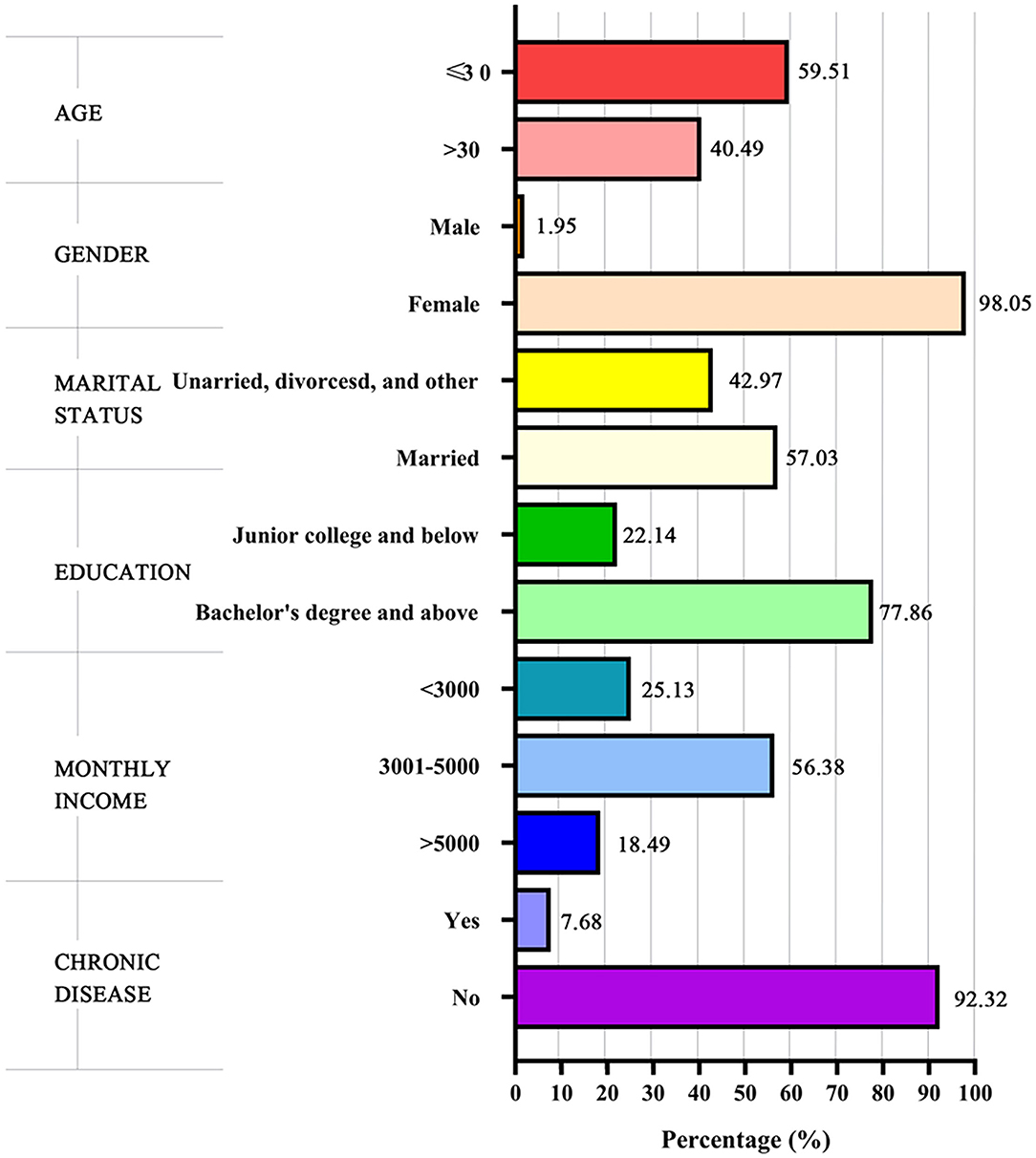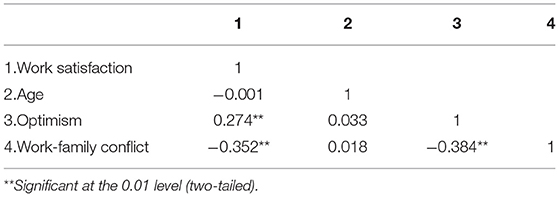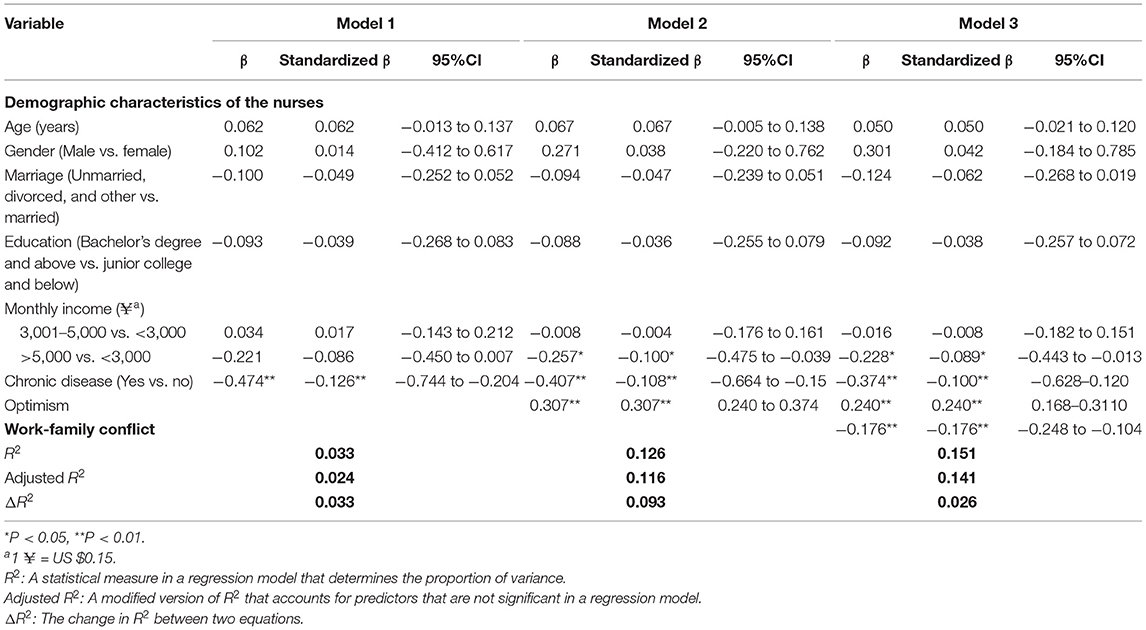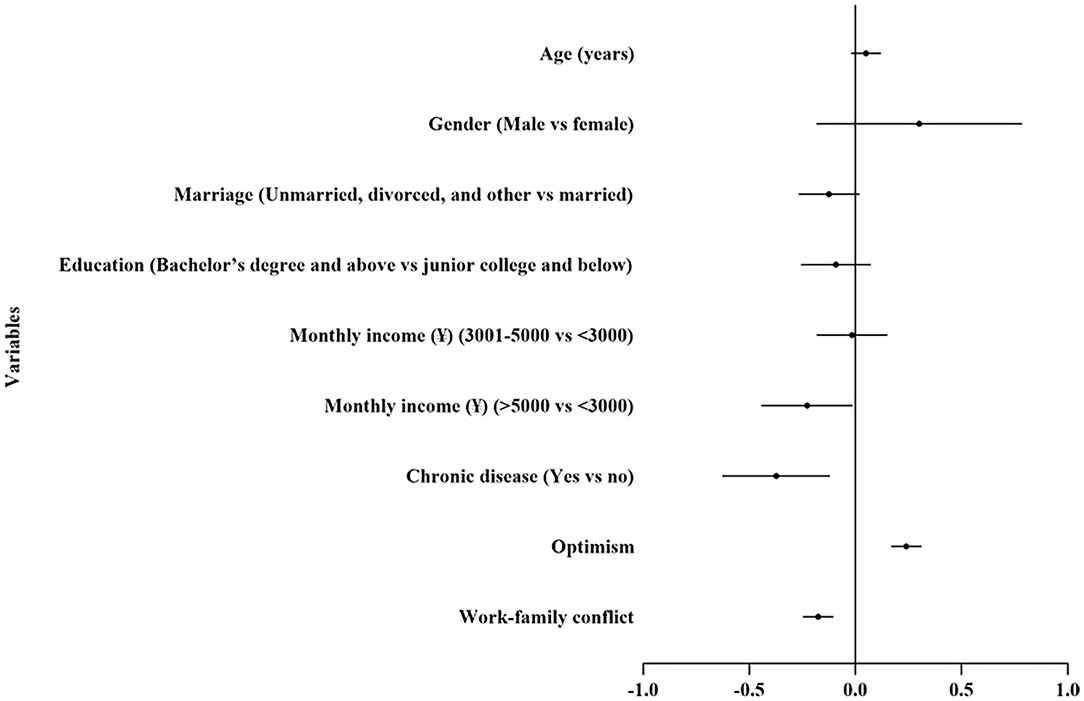- 1Department of Social Medicine, College of Health Management, China Medical University, Shenyang, China
- 2Department of Intensive Care Unit, Cancer Hospital of China Medical University, Liaoning Cancer Hospital and Institute, Shenyang, China
- 3Faculty of Medical and Health Sciences, School of Population Health, The University of Auckland, Auckland, New Zealand
- 4Department of Public Health, Pennsylvania State University College of Medicine, Hershey, PA, United States
Background: Nurses are suffering from various stressors which adversely impact their work satisfaction and mental health. Research is scarce on optimism, one of the positive psychological resource which may reduce work-family conflict and improve work satisfaction.
Objectives: This study aims to assess work satisfaction among Chinese nurses and to observe and illustrate the relationships among optimism, work-family conflict, and work satisfaction.
Methods: This study was designed as a cross-sectional study with stratified sampling. From September 2019 to December 2020, a self-administered WeChat questionnaire was collected from 768 nurses online in China to evaluate the nurses' work satisfaction, optimism, and work-family conflict. Spearman correlation and hierarchical multiple regression analysis were applied to examine associated factors of work satisfaction. A structural equation model was employed to test the mediating effect of work-family conflict in the relationship between optimism and work satisfaction.
Results: Optimism were observed to have a positive correlation with work satisfaction while the correlation between work-family conflict and work satisfaction was observed to be negative. Optimism and work-family conflict explained 4.8 and 9.2% of the incremental variances of work satisfaction, respectively. Work-family conflict served as a mediator in the relationship between optimism and work satisfaction.
Conclusions: Nurses in China experienced high levels of work satisfaction. Optimism could increase the chance of higher work satisfaction while work-family conflict increased the risk of lower work satisfaction. Psychological interventions and improvement of working conditions are essential to relieve work-family conflicts and enhance work satisfaction.
Introduction
The roles of nurses are more and more manifold and important in modern health care (1, 2). There are 4,445,047 certified nurses in China (3). With high demands of care responsibilities and rigorous training, stressors such as work-family conflict, nurse-patient conflict, long working hours, heavy workload, low promotion prospects, can adversely impact nurses' mental health, and work satisfaction (2–6).
Work satisfaction is the affective orientation that an employee holds to their work, comprising of two dimensions: intrinsic work satisfaction and extrinsic work satisfaction (7–11). The model of work environment satisfaction suggests that nurses' health and well-being are related to work satisfaction (12, 13). At the same time, dissatisfaction with work were found to be associated with increasing mental distress including anger, burnout, work stress, and frustration (10, 14–19). Furthermore, poor work satisfaction can result in decreasing health care quality (20). Therefore, the enhancement of work satisfaction of nurses is necessary to promote the health of both nurses and patients.
The proposed theoretical models explain the association between optimism and work satisfaction, by postulating that optimism could impact work satisfaction via various ways including improvements in work autonomy, enhancement in self-perception of health, promotion of perceived organizational support, etc. (21–24). Optimism is the positive and realistic expectation for success for the present and the future (25). Prior research has indicated the significant predictive power of optimism to work satisfaction and mental health (22, 26, 27). Related studies have found significant correlation between work satisfaction, optimism, and psychosomatic symptoms including fatigue, insomnia, breathing difficulties, etc. (28). Additionally, optimism can improve other positive work-related factors such as coping strategies, social resources, work engagement, work immersion, or organizational identification either directly or indirectly via mediation (29–33). In a word, promoting optimism among nurses can improve psychosomatic health and work satisfaction.
Besides optimism, it has been proved that work-family conflict has a close association with work satisfaction (34, 35). Work-family conflict refers to a psychological phenomenon of imbalance between work and family life (36). Studies have found that work-family conflict negatively associated with work satisfaction (37, 38). Work-family conflict can mediate the relationship between work satisfaction and work-satisfaction-related factors such as social support, professional values, and turnover intention (39–44). Work-family conflicts also exert effects on mental health, inducing burnout and depression (45, 46). A synthetic model of work-family demands and distress indicated that greater work-family conflict is predictive of depression (47). Thus, we hypothesized that work-family conflict might mediate the relationship between work satisfaction and other potential positive psychological factors, such as optimism. Efforts to mitigate work-family conflict may play a significant role in promoting work satisfaction among nurses.
Although increasing research has paid close attention to the mental health and work satisfaction among nurses, further studies are essential to explore the relationship among psychological factors, work-related factors, and work satisfaction with work-family conflict as a mediator (1, 48). Therefore, this study aimed to measure work satisfaction, optimism, and work-family conflict among Chinese nurses, and to investigate the potential relationships among them. The hypotheses of this study are as follows.
Hypothesis 1: Higher level of optimism is related with higher level of work satisfaction.
Hypothesis 2: Work-family conflict negatively impacts work satisfaction.
Hypothesis 3: Work-family conflict mediates the relationship between optimism and work satisfaction.
Materials and Methods
Participants, Procedure, and Ethics Statement
From September 2019 to December 2020, a multicenter cross-sectional survey designed with stratified sampling was carried out in Henan province and Liaoning province in China according to the distribution of population and nurses. With the preliminary communication with staff in the departments of medical administration, a total of 6 public hospitals (3 in Henan province and 3 in Liaoning province) were chosen as survey sites. Approximately 30% of the nurses working for clinical departments including internal medicine department, surgery department, emergency department, gynecology and pediatrics department, etc., were collected randomly as sample. A self-administered online questionnaire developed by Wenjuanxing, a widely used online questionnaire platform in China, was distributed via working group chat with a QR code. The inclusion criteria were as follows: Qualification Certificate of Specialty and Technology in Nursing obtained; at least 20 years of age; able to independently complete the online questionnaire in Chinese; able to provide signed informed consent and take part in the study voluntarily. The inform consent included the aims of this study, the further use of the data, and the strict protection of their privacy in this study. Only the participants checked the inform consent can they started the following online survey. Participants who met any of the criteria as follows were excluded: being diagnosed or treated with a severe mental illness (e.g., bipolar disorder, schizoaffective psychosis, paranoiac psychosis, etc.); suffering from conditions which prevented participation in this survey (e.g., visual impairment).
The questionnaire contained the Minnesota Satisfaction Questionnaire, Life Orientation Test- revised, Work-family Conflict Scale, and self-developed questions on demographic characteristics (49–51). The validated questionnaire took about 25 min to complete. A total of 768 nurses accomplished and submitted the questionnaire. The study complied with the Declaration of Helsinki as revised in 1989, and the protocol was authorized by the Ethics Committee of China Medical University (ID: 2020048).
Baseline Characteristics of the Nurses
The collected baseline characteristics of the nurses included age, sex (male, female), marital status (married, other), education (junior college and below, bachelor degree, and above) monthly income [ ≤ 3,000 yuan ( ≤ US $464.4), 3,001–5,000 yuan (US $464.4 to $774.0), and >5,000 yuan (>US $774.0)]), and chronic disease including hypertension, coronary heart disease, diabetes, cancer, etc. (yes, no).
Assessment of Work Satisfaction
Work satisfaction of nurses was measured with the Chinese version of the Minnesota Satisfaction Questionnaire (MSQ) (49, 50). The MSQ comprised of two subscales, including intrinsic work satisfaction and extrinsic work satisfaction. Participants rated each item of MSQ according to 5-point Likert-type scale (1 = very dissatisfied; 2 = dissatisfied; 3 = neutral; 4 = satisfied; 5 = very satisfied). The Cronbach's alpha for MSQ in this study was 0.977.
Assessment of Optimism
Optimism of nurses was measured with the Chinese version of the Life Orientation Test- revised (LOT-R) (51). The scales contained 6 items with 5-point Likert-type scale (1 = strongly disagree; 2 = disagree; 3 = neutral; 4 = agree; 5 = strongly agree). The Cronbach's alpha for LOT-R in this study was 0.650.
Assessment of Work-Family Conflict
Work-family conflict of nurses was evaluated with the Chinese version of the Work-family Conflict Scale (WFC) (52). The WFC contained two subscales, work interference with family conflict (WIF) and family interference with work conflict (FIW). Both of the subscales comprised of conflicts of time, stress and behaviors (53). Participants rated each item with 5-point Likert-type scale (1 = strongly disagree; 2 = disagree; 3 = neutral; 4 = agree; 5 = strongly agree). The Cronbach's alpha for WFC in this study was 0.954.
Statistical Analyses
SPSS version 23.0 and Amos 17.0 statistical software for Windows (IBM Corporation) were employed to conduct the statistical analyses. The relationship between work satisfaction and demographic variables were explored with t-tests and one-way analysis of variance (ANOVA). The Spearman correlation analysis was conducted to test the correlations between work satisfaction, optimism, and work-family conflict. A hierarchical multiple regression (HMR) analysis was applied to explore associate factors of work satisfaction and their corresponding incremental contributions: Step 1: baseline characteristics of the nurses; Step 2: optimism of the nurses; Step 3: work-family conflict of the nurses. The work satisfaction scores, as the dependent variable, were continuous in HMR. The magnitude of associations between the dependent and independent variables were evaluated with standardized parameter estimates (standardized β). The mediating role of work-family conflict was explored using Structural Equation Models (SEM), with work satisfaction as the dependent variable, optimism as the independent variable, and work-family conflict as the mediator. A two-tailed P < 0.05 was considered to be statistically significant.
Results
Baseline Characteristics of the Participants
The average score of the nurses' work satisfaction, optimism, and work-family conflict was 76.40 ± 16.26, 20.52 ± 3.50, and 51.31±14.91, respectively. The nurses' baseline characteristics and the distribution of work satisfaction are illustrated in Table 1 and Figure 1. A total of 768 nurses participated in the study. The mean age was 31 years and most of the participants were female (753, 98.05%). About half of the participants were married (438, 57.03%). More than three-quarters of the participants had a bachelor's degree or above (598, 77.86%). The results of the univariate analysis manifested that the work satisfaction scores were lower among participants who had a higher monthly income (P = 0.014). Participants who suffered from chronic diseases had lower work satisfaction (P = 0.001).
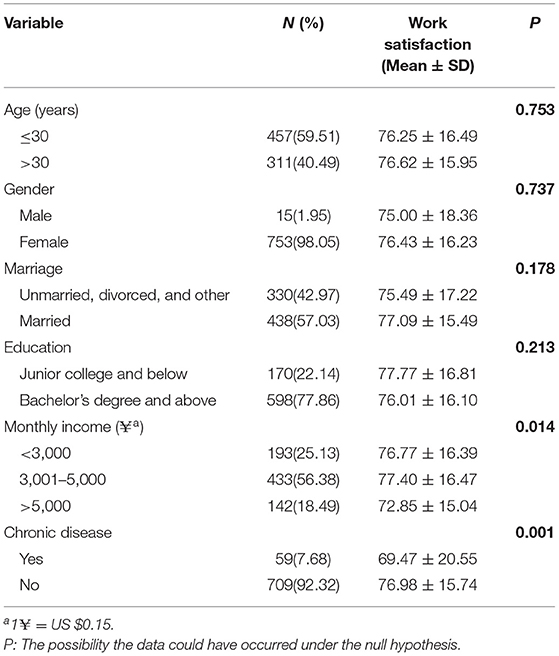
Table 1. Baseline characteristics of the distribution of the work satisfaction among nurses (N = 768).
Correlations Between Work Satisfaction, Optimism, and Work-Family Conflict
Table 2 shows that work satisfaction was significantly associated with optimism and work-family conflict (P < 0.01). Optimism had a positive correlation with work satisfaction (P < 0.01), whereas work-family conflict had a negative correlation with both work satisfaction and optimism (P < 0.01).
Factors Associated With Work Satisfaction
The final results of the HMR models for work satisfaction among the nurses are presented in Table 3. A total of 15.1% of the variance was explained by the final model. Demographic characteristics, optimism, and work-family conflict explained 3.3, 4.8, and 9.2% of the incremental variances, respectively. According to the forest plot (Figure 2), optimism had a positive association with work satisfaction (P < 0.001). At the same time, work-family conflict had a negative association with work satisfaction (P < 0.001). Higher monthly income (>5,000 yuan) (P = 0.038) and suffering from a chronic disease (P = 0.004) were negatively associated with work satisfaction.
Work-Family Conflict as a Mediator Between Work Satisfaction and Optimism
Table 4 present the outcomes of SEM analysis. The path coefficients and standardized solution for SEM are illustrated in Figures 3, 4. Optimism influenced work satisfaction directly (c = 0.37, P < 0.001). Optimism was positively associated with the work satisfaction (P < 0.001). The model fit indices were ideal (χ2/df = 2.636 <5, GFI = 0.990 > 0.9, AGFI = 0.970 > 0.9, CFI = 0.993 > 0.9, TLI = 0.984 > 0.9, RMSEA = 0.046 <0.05) (Figure 3). Work-family conflict had a significant association with work satisfaction (P < 0.001).

Figure 3. Standardized solution for the structural equation model of optimism and work satisfaction. **P < 0.01.
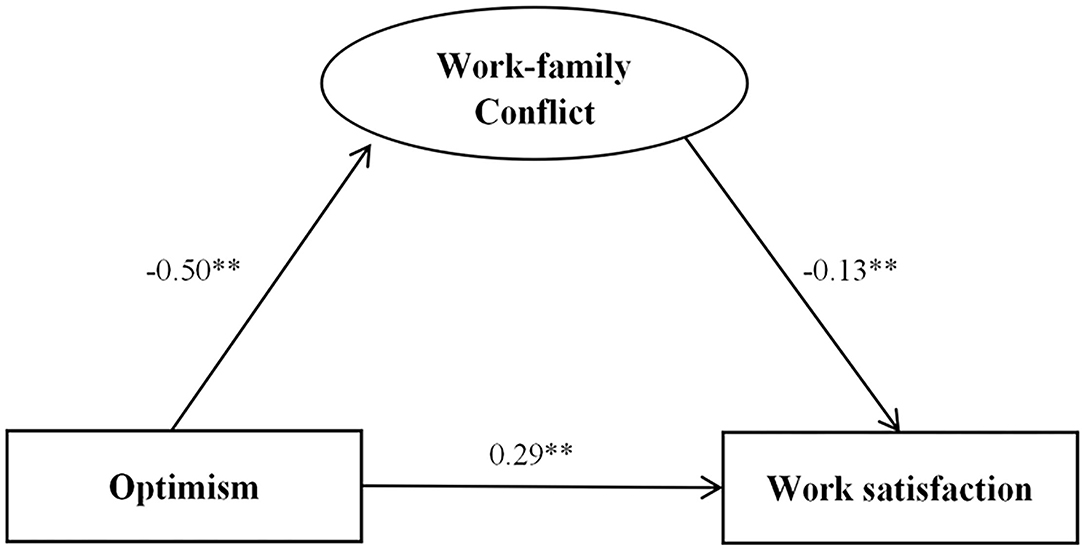
Figure 4. Standardized solution for the structural equation model of work-family conflict, optimism, and work satisfaction. **P < 0.01.
The path coefficient of optimism with work satisfaction decreased significantly when work-family conflict was considered as a mediator (c = 0.29, P < 0.001) (Figure 4). The direct path coefficient of optimism on work satisfaction was reduced or lost statistical significance after including the mediator, work-family conflict, which also suggested that the mediation effect existed. Work-family conflict mediated the association between optimism and work satisfaction (a*b = 0.08, BCa95%CI: 0.113–1.329, Percentile 95%CI: 0.111–1.326). The model fit indices were also ideal (χ2/df = 2.779 <5, GFI = 0.975 > 0.9, AGFI = 0.947 > 0.9, CFI = 0.986 > 0.9, TLI = 0.974 > 0.9, RMSEA=0.048 <0.05).
Discussion
Principal Findings
The average score of the nurses' work satisfaction, optimism and work-family conflict was 76.40 ± 16.26, 20.52 ± 3.50, and 51.31 ± 14.91 in this study, respectively. The correlations among work satisfaction, optimism, and work-family conflict were significant. Besides, this study observed that work-family conflict partially mediated the association between optimism and work satisfaction. According to other research which used the MSQ to measure work satisfaction of nurses, the level of work satisfaction among nurses was slightly higher than that of physicians in China (62.2–71.6) (24, 54, 55). Although there were studies which have explored the relationship among work satisfaction, optimism, and work-family conflict, the research investigated the role of work-family conflict in the relationship between optimism and work satisfaction remains scarce (56, 57).
In this study, optimism had a positive association with work satisfaction, which is consistent with former research (23, 24). According to the HMR analysis, optimism was a protective factor for work satisfaction, indicating that optimism may increase the chances of higher work satisfaction. As positive psychological capital, optimism can directly influence work autonomy, which can improve work satisfaction among health care workers (21). Therefore, through the promotion of optimism, nurses may enhance their abilities to cope with work tasks and improve their work satisfaction (22).
A negative correlation was observed between optimism and work-family conflict. Optimism can alleviate the negative outcomes of work-family conflict such as reduced work performance, decreased life and work satisfaction, and increased work pressure (55, 58–60). A study by Hao et al. found that optimism partially mediated the relationship between work-family conflict and depression (56). While the research focused on the relationship between optimism and work-family conflict is scarce, the role of optimism in work-family conflict still deserves exploration to improve work satisfaction and mental health.
Additionally, in this study, a negative correlation was observed between work-family conflict and work satisfaction, which is in agreement with previous research (61, 62). HMR analysis indicated that work-family conflict was a risk factor for poor work satisfaction. Additionally, work-family conflict was observed to have a mediating effect in the relationship between optimism and work satisfaction. When work-family conflict was considered as a mediator, the positive effect of optimism on work satisfaction was negatively impacted, indicating that optimism can prompt work satisfaction by effective control and decrease in work-family conflict. Working in an environment which requires a high level of ethics, responsibility, training, and specialization, work-family conflict is an adverse factor that intensifies the negative experience in nurses' career life (42, 63–66). Previous studies have found that work-family conflict could serve as a mediator in the relationship between work satisfaction and doctor-patient relationship, turnover intention, role commitment, and work involvement (42, 63–66). This study indicates that the reduction or elimination of work-family conflict is urgently needed to improve nurses' work satisfaction, which is also necessary for better patient outcomes.
Optimism and work-family conflict are critical factors linked with work satisfaction among nurses. Meanwhile, work-family conflict serves as a mediator between optimism and work satisfaction. Therefore, a supportive work environment should be developed with effective measures to set reduction of work-family conflict, enhance nurses' psychological health, and promote their work satisfaction; ultimately improving quality of care.
Limitations
Several limitations should be acknowledged in this study. First, since the survey was conducted among nurses in two provinces in China, Henan and Liaoning, the generalizability to other populations is limited. Second, since this study was carried out from September 2019 to December 2020, the outcomes of this study may be limited by the outbreak of Coronavirus Disease-19 (COVID-19) pandemic and other unmeasured confounders. Third, selection bias cannot be ruled out because the survey was conducted online and the participants were smart phone users only. Finally, the baseline characteristics did not include professional factors such as year of experience, specialty and professional title, which should be added in the future studies.
Conclusions
Nurses in China experience a high level of work satisfaction. Optimism increases work satisfaction while work-family conflict lowers work satisfaction and serves as a mediator between optimism and work satisfaction. The findings manifest that measures such as effective psychological interventions to increase optimism and to reduce work-family conflict should be taken to protect nurses' mental health, enhance nurse's work satisfaction, and importantly, to increase the quality of medical care for patients.
Data Availability Statement
The raw data supporting the conclusions of this article will be made available by the authors, without undue reservation.
Ethics Statement
The studies involving human participants were reviewed and approved by the Ethics Committee of China Medical University. The patients/participants provided their written informed consent to participate in this study.
Author Contributions
WZ and ZZ analyzed the data and drafted and revised the manuscript. RP, JZ, and KS revised the manuscript. CC contributed to the acquisition and interpretation of data. XY was responsible for the conception and design and the revision of the manuscript. All authors contributed to the article and approved the submitted version.
Funding
This work was supported by the fellowship of China Postdoctoral Science Foundation (2020M681022).
Conflict of Interest
The authors declare that the research was conducted in the absence of any commercial or financial relationships that could be construed as a potential conflict of interest.
Publisher's Note
All claims expressed in this article are solely those of the authors and do not necessarily represent those of their affiliated organizations, or those of the publisher, the editors and the reviewers. Any product that may be evaluated in this article, or claim that may be made by its manufacturer, is not guaranteed or endorsed by the publisher.
Acknowledgments
All of the co-author appreciate the cooperation of participants and the generous contributions from research assistants.
References
1. Bae SH. Nurse practitioners' job satisfaction in rural versus nonrural areas. J Am Assoc Nurse Pract. (2016) 28:471–8. doi: 10.1002/2327-6924.12362
2. Cicolini G, Comparcini D, Simonetti V. Workplace empowerment and nurses' job satisfaction: a systematic literature review. J Nurs Manag. (2014) 22:855–71. doi: 10.1111/jonm.12028
3. National Health Commission of the People's Republic of China. The China Health Statistical Yearbook. Beijing (2020).
4. Boamah SA, Read EA, Spence Laschinger HK. Factors influencing new graduate nurse burnout development, job satisfaction and patient care quality: a time-lagged study. J Adv Nurs. (2017) 73:1182–95. doi: 10.1111/jan.13215
5. Caricati L, Sala RL, Marletta G, Pelosi G, Ampollini M, Fabbri A, et al. Work climate, work values and professional commitment as predictors of job satisfaction in nurses. J Nurs Manag. (2014) 22:984–94. doi: 10.1111/jonm.12079
6. Spence Laschinger HK, Leiter M, Day A, Gilin D. Workplace empowerment, incivility, and burnout: impact on staff nurse recruitment and retention outcomes. J Nurs Manag. (2009) 17:302–11. doi: 10.1111/j.1365-2834.2009.00999.x
7. Price JL. Reflections on the determinants of voluntary turnover. Int J Manpow. (2001) 22:600–24. doi: 10.1108/EUM0000000006233
8. Lu H, While AE, Barriball KL. A model of job satisfaction of nurses: a reflection of nurses' working lives in Mainland China. J Adv Nurs. (2007) 58:468–79. doi: 10.1111/j.1365-2648.2007.04233.x
9. Misener TR, Cox DL. Development of the misener nurse practitioner job satisfaction scale. J Nurs Meas. (2001) 9:91–108. doi: 10.1037/t44056-000
10. Pasarón R. Nurse practitioner job satisfaction: looking for successful outcomes. J Clin Nurs. (2013) 22:2593–604. doi: 10.1111/j.1365-2702.2012.04331.x
11. Pron AL. Job satisfaction and perceived autonomy for nurse practitioners working in nurse-managed health centers. J Am Assoc Nurse Pract. (2013) 25:213–21. doi: 10.1111/j.1745-7599.2012.00776.x
12. Chung HC, Chen YC, Chang SC, Hsu WL, Hsieh TC. Nurses' well-being, health-promoting lifestyle and work environment satisfaction correlation: a psychometric study for development of nursing health and job satisfaction model and scale. Int J Environ Res Public Health. (2020) 17:3582. doi: 10.3390/ijerph17103582
13. Liu K, You LM, Chen SX, Hao YT, Zhu XW, Zhang LF, et al. The relationship between hospital work environment and nurse outcomes in Guangdong, China: a nurse questionnaire survey. J Clin Nurs. (2012) 21:1476–85. doi: 10.1111/j.1365-2702.2011.03991.x
14. La IS, Yun EK. Effects of trait anger and anger expression on job satisfaction and burnout in preceptor nurses and newly graduated nurses: a dyadic analysis. Asian Nurs Res. (2019) 13:242–8. doi: 10.1016/j.anr.2019.09.002
15. Han J, Kang HJ, Kwon GH. Impact of intelligent healthscape quality on nurse job outcomes and job satisfaction: a test of the moderating effect of innovativeness. J Nurs Manag. (2020) 28:43–53. doi: 10.1111/jonm.12875
16. Danaci E, Koç Z. The association of job satisfaction and burnout with individualized care perceptions in nurses. Nurs Ethics. (2020) 27:301–15. doi: 10.1177/0969733019836151
17. Hoff T, Carabetta S, Collinson GE. Satisfaction, burnout, and turnover among nurse practitioners and physician assistants: a review of the empirical literature. Med Care Res Rev. (2019) 76:3–31. doi: 10.1177/1077558717730157
18. Jaradat YM, Nielsen MB, Kristensen P, Bast-Pettersen R. Shift work, mental distress and job satisfaction among Palestinian nurses. Occup Med. (2017) 67:71–4. doi: 10.1093/occmed/kqw128
19. Cousins R, Donnell C. Nurse prescribing in general practice: a qualitative study of job satisfaction and work-related stress. Fam Pract. (2012) 29:223–7. doi: 10.1093/fampra/cmr077
20. Karlsson AC, Gunningberg L, Bäckström J, Pöder U. Registered nurses' perspectives of work satisfaction, patient safety and intention to stay - a double-edged sword. J Nurs Manag. (2019) 27:1359–65. doi: 10.1111/jonm.12816
21. Dai B, Akey-Torku B. The influence of managerial psychology on job satisfaction among healthcare employees in Ghana. Healthcare. (2020) 8:262. doi: 10.3390/healthcare8030262
22. Hernández-Varas E, Labrador Encinas FJ, Méndez Suárez M. Psychological capital, work satisfaction and health self-perception as predictors of psychological wellbeing in military personnel. Psicothema. (2019) 31:277–83. doi: 10.7334/psicothema2019.22
23. Durukan Köse S, Köse T, Ugurluoglu Ö. The antecedent of organizational outcomes is psychological capital. Health Soc Work. (2018) 43:155–64. doi: 10.1093/hsw/hly020
24. Fu J, Sun W, Wang Y, Yang X, Wang L. Improving job satisfaction of Chinese doctors: the positive effects of perceived organizational support and psychological capital. Public Health. (2013) 127:946–51. doi: 10.1016/j.puhe.2012.12.017
25. Eid J, Mearns K, Larsson G, Laberg JC, Johnsen BH. Leadership, psychological capital and safety research: Conceptual issues and future research questions. Saf Sci. (2012) 50:55–61. doi: 10.1016/j.ssci.2011.07.001
26. Park MS, Goto N, Kennedy A, Raj S, Dutson A, Park L, et al. Positive orientation, job satisfaction and psychological well-being of mental health practitioners in Malaysia. Psychol Health Med. (2020) 5:1–11. doi: 10.1080/13548506.2020.1804599
27. Salles FLP, d'Angelo MJ. Assessment of psychological capital at work by physiotherapists. Physiother Res Int. (2020) 25:e1828. doi: 10.1002/pri.1828
28. Al-Mashaan OS. Associations among job satisfaction, optimism, pessimism, and psychosomatic symptoms for employees in the government sector in Kuwait. Psychol Rep. (2003) 93:17–25. doi: 10.2466/pr0.2003.93.1.17
29. Zhang T, Wei Q, Ma SY, Li HP. The relationship between optimism and job satisfaction for Chinese specialist nurses: a serial-multiple mediation model. Jpn J Nurs Sci. (2020) 17:e12334. doi: 10.1111/jjns.12334
30. Shang Guan CY, Li Y, Ma HL. The mediating role of psychological capital on the association between occupational stress and job satisfaction among township cadres in a specific province of china: a cross-sectional study. Int J Environ Res Public Health. (2017) 14:972. doi: 10.3390/ijerph14090972
31. Hakanen JJ, Lindbohm ML. Work engagement among breast cancer survivors and the referents: the importance of optimism and social resources at work. J Cancer Surviv. (2008) 2:283–95. doi: 10.1007/s11764-008-0071-0
32. Jiang ZQ, Zhou SX. The relationships among job immersion, psychological capital, and life quality in nursing staffs (a STROBE-compliant article). Medicine. (2020) 99:e22765. doi: 10.1097/MD.0000000000022765
33. Lu L, Liu L, Sui G, Wang L. The associations of job stress and organizational identification with job satisfaction among chinese police officers: the mediating role of psychological capital. Int J Environ Res Public Health. (2015) 12:15088–99. doi: 10.3390/ijerph121214973
34. Chan XW, Kalliath P, Chan C, Kalliath T. How does family support facilitate job satisfaction? Investigating the chain mediating effects of work-family enrichment and job-related well-being. Stress Health. (2020) 36:97–104. doi: 10.1002/smi.2918
35. Wei W, Guo M, Ye L, Liao G, Yang Z. Work-family conflict and safety participation of high-speed railway drivers: Job satisfaction as a mediator. Accid Anal Prev. (2016) 95(Pt A):97–103. doi: 10.1016/j.aap.2016.06.022
36. Csikszentmihalyi M. Good Business: Leadership. Flow and the Making of Meaning. New York, NY: Viking (2003).
37. Zito M, Colombo L, Borgogni L, Callea A, Cenciotti R, Ingusci E, Cortese CG. The nature of job crafting: positive and negative relations with job satisfaction and work-family conflict. Int J Environ Res Public Health. (2019) 16:1176. doi: 10.3390/ijerph16071176
38. Gao Y, Shi J, Niu Q, Wang L. Work-family conflict and job satisfaction: emotional intelligence as a moderator. Stress Health. (2013) 29:222–8. doi: 10.1002/smi.2451
39. Yang S, Liu D, Liu H, Zhang J, Duan Z. Relationship of work-family conflict, self-reported social support and job satisfaction to burnout syndrome among medical workers in southwest China: a cross-sectional study. PLoS ONE. (2017) 12:e0171679. doi: 10.1371/journal.pone.0171679
40. Gardner C, Hailey A, Nguyen C, Prichard C, Newcomb P. Wired to the Workplace: The Relationship Between Electronic Connectedness to Work and Nurse Manager Satisfaction. J Nurs Adm. (2017) 47:16–23. doi: 10.1097/NNA.0000000000000431
41. Yarbrough S, Martin P, Alfred D, McNeill C. Professional values, job satisfaction, career development, and intent to stay. Nurs Ethics. (2017) 24:675–85. doi: 10.1177/0969733015623098
42. Chen IH, Brown R, Bowers BJ, Chang WY. Work-to-family conflict as a mediator of the relationship between job satisfaction and turnover intention. J Adv Nurs. (2015) 71:2350–63. doi: 10.1111/jan.12706
43. Eckerson CM. The impact of nurse residency programs in the United States on improving retention and satisfaction of new nurse hires: an evidence-based literature review. Nurse Educ Today. (2018) 71:84–90. doi: 10.1016/j.nedt.2018.09.003
44. Hyrkäs K, Dende D. Perspectives on nursing job satisfaction, the work environment and burnout. J Nurs Manag. (2009) 17:267–8. doi: 10.1111/j.1365-2834.2009.01011.x
45. Terry DL, Woo MJ. Burnout, job satisfaction, and work-family conflict among rural medical providers. Psychol Health Med. (2021) 26:196–203. doi: 10.1080/13548506.2020.1750663
46. Kan D, Yu X. Occupational stress, work-family conflict and depressive symptoms among chinese bank employees: the role of psychological capital. Int J Environ Res Public Health. (2016) 13:134. doi: 10.3390/ijerph13010134
47. Namazi S, Dugan AG, Fortinsky RH, Barnes-Farrell J, Coman E, El Ghaziri M, et al. Examining a comprehensive model of work and family demands, work-family conflict, and depressive symptoms in a sample of correctional supervisors. J Occup Environ Med. (2019) 61:818–28. doi: 10.1097/JOM.0000000000001664
48. Zheng J, Wu G. Work-family conflict, perceived organizational support and professional commitment: a mediation mechanism for chinese project professionals. Int J Environ Res Public Health. (2018) 15:344. doi: 10.3390/ijerph15020344
49. Weiss DJ, Dawis RV, England GW. Manual for the Minnesota satisfaction questionnaire. Minnesota Stud. Vocational Rehabil. (1967) 22:120.
50. Cheung T, Lee PH, Yip PSF. The association between workplace violence and physicians' and nurses' job satisfaction in Macau. PLoS ONE. (2018) 13:e0207577. doi: 10.1371/journal.pone.0207577
51. Scheier MF, Carver CS, Bridges MW. Distinguishing optimism from neuroticism (and trait anxiety, self-mastery, and self-esteem): a reevaluation of the Life Orientation Test. J Pers Soc Psychol. (1994) 67:1063–78. doi: 10.1037//0022-3514.67.6.1063
52. Carlson DS, Kacmar KM. Work–family conflict in the organization: do life role values make a difference? J. Manag. (2000) 26:1031–54. doi: 10.1016/S0149-2063(00)00067-2
53. Carlson DS, Frone MR. Relation of behavioral and psychological involvement to a new four-factor conceptualization of work-family interference. J Bus Psychol. (2003) 17:515–35. doi: 10.1023/A:1023404302295
54. Yu X, Zheng M, Cheng X, Xu B, Tao Z, Ding J, et al. Job satisfaction among doctors from Jiangsu Province in China. Med Sci Monit. (2018) 24:7162–9. doi: 10.12659/MSM.912712
55. Jiang F, Hu L, Rakofsky J, Liu T, Wu S, Zhao P, et al. Sociodemographic characteristics and job satisfaction of psychiatrists in China: results from the first nationwide survey. Psychiatr Serv. (2018) 69:1245–51. doi: 10.1176/appi.ps.201800197
56. Hao J, Wu D, Liu L, Li X, Wu H. Association between work-family conflict and depressive symptoms among Chinese female nurses: the mediating and moderating role of psychological capital. Int J Environ Res Public Health. (2015) 12:6682–99. doi: 10.3390/ijerph120606682
57. Mache S, Bernburg M, Vitzthum K, Groneberg DA, Klapp BF, Danzer G. Managing work-family conflict in the medical profession: working conditions and individual resources as related factors. BMJ Open. (2015) 5:e006871. doi: 10.1136/bmjopen-2014-006871
58. Adkins CL, Premeaux SF. Spending time: the impact of hours worked on work–family conflict. J Vocat Behav. (2012) 80:380–9. doi: 10.1016/j.jvb.2011.09.003
59. Wang Y, Liu L, Wang J, Wang L. Work-family conflict and burnout among Chinese doctors: the mediating role of psychological capital. J Occup Health. (2012) 54:232–40. doi: 10.1539/joh.11-0243-oa
60. Wang Y, Chang Y, Fu J, Wang L. Work-family conflict and burnout among Chinese female nurses: the mediating effect of psychological capital. BMC Public Health. (2012) 12:915. doi: 10.1186/1471-2458-12-915
61. Ding X, Yang Y, Su D, Zhang T, Li L, Li H. Can job control ameliorate work-family conflict and enhance job satisfaction among Chinese registered nurses? A mediation model. Int J Occup Environ Med. (2018) 9:97–105. doi: 10.15171/ijoem.2018.1176
62. Gopalan N, Pattusamy M. Role of work and family factors in predicting career satisfaction and life success. Int J Environ Res Public Health. (2020) 17:5096. doi: 10.3390/ijerph17145096
63. Deng S, Yang N, Li S, Wang W, Yan H, Li H. Doctors' job satisfaction and its relationships with doctor-patient relationship and work-family conflict in china: a structural equation modeling. Inquiry. (2018) 55:46958018790831. doi: 10.1177/0046958018790831
64. Chan HC, Jiang D, Fung HH. Role conflict and satisfaction in the work-family context: age differences in the moderating effect of role commitment. Psych J. (2015) 4:20–7. doi: 10.1002/pchj.89
65. Liu J, Lambert EG, Kelley T, Zhang J, Jiang S. Exploring the association between work-family conflict and job involvement. Int J Offender Ther Comp Criminol. (2020) 64:791–817. doi: 10.1177/0306624X19896463
Keywords: work satisfaction, optimism, work-family conflict, nurses, mental health
Citation: Zhang W, Zheng Z, Pylypchuk R, Zhao J, Sznajder KK, Cui C and Yang X (2021) Effects of Optimism on Work Satisfaction Among Nurses: A Mediation Model Through Work-Family Conflict. Front. Psychiatry 12:779396. doi: 10.3389/fpsyt.2021.779396
Received: 18 September 2021; Accepted: 01 November 2021;
Published: 25 November 2021.
Edited by:
Roy Abraham Kallivayalil, Pushpagiri Medical College, IndiaReviewed by:
Ting Liu, The Chinese University of Hong Kong, Hong Kong SAR, ChinaMarques Shek Nam Ng, The Chinese University of Hong Kong, Hong Kong SAR, China
Copyright © 2021 Zhang, Zheng, Pylypchuk, Zhao, Sznajder, Cui and Yang. This is an open-access article distributed under the terms of the Creative Commons Attribution License (CC BY). The use, distribution or reproduction in other forums is permitted, provided the original author(s) and the copyright owner(s) are credited and that the original publication in this journal is cited, in accordance with accepted academic practice. No use, distribution or reproduction is permitted which does not comply with these terms.
*Correspondence: Xiaoshi Yang, eHN5YW5nQGNtdS5lZHUuY24=
†These authors have contributed equally to this work and share first authorship
 Weiyu Zhang
Weiyu Zhang Zhen Zheng
Zhen Zheng Romana Pylypchuk
Romana Pylypchuk Jinfeng Zhao
Jinfeng Zhao Kristin K. Sznajder
Kristin K. Sznajder Can Cui
Can Cui Xiaoshi Yang
Xiaoshi Yang